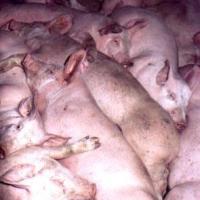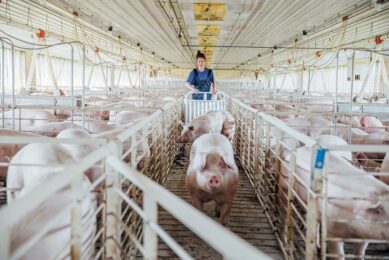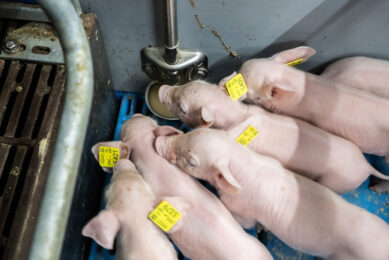Study at reducing pleuritis in slaughter pigs

A study instigated by the Product Boards for Livestock, Meat and Eggs together with the Animal Sciences Group, VC Someren and Intervet investigated whether the number of slaughter pigs with pleuritis can be reduced.
In the Netherlands, the prevalence of chronic pleuritis in slaughter pigs has increased from 12% in1990 to 22.5% in 2004. The aim of the study was to determine whether restricted contact structures (strict all-in allout and no regrouping and mixing of pigs) reduces the number of slaughter pigs with pleuritis.
Pigs from 171 litters were monitored from birth to slaughter at the Experimental Farm Sterksel. Four production groups were monitored.
There were two experimental treatments:
1) Mixing (control group): Cross-fostering was allowed between all litters in the control group. At weaning, all litters were mixed and piglets in a pen were blocked by body weight. After 5½ weeks, pigs were moved to the grower and finisher rooms. Pigs were mixed again and blocked by body weight.
2) Non-mixing (experimental group): Cross-fostering was only allowed within three days after birth and between two litters. From three days after birth till delivery to the slaughter house, litters were kept together. At weaning, litters from one farrowing room were placed in one room for weaned piglets. After 5½ weeks, litters from one room for weaned piglets were placed in one room for growing and finishing pigs. A strict hygiene protocol was used for the pigs in the non-mixing group.
The main results and conclusions of this study are:
- Piglets in the non-mixing group grew faster during the suckling period and were heavier at weaning than piglets in the mixing group.
- Piglet mortality during the suckling period did not differ between the mixing and the non-mixing group.
- Inthe mixing group more piglets were treated for lameness.
- Daily gain, feed intake, feed conversion ratio, mortality and number of piglets that were veterinary treated were similar in weaned piglets in the mixing and non-mixing group.
- Growing and finishing pigs in the non-mixing group grew faster (16g/d) and had thicker muscles at slaughter (1.1 mm) than those in the mixing group. Feed intake and feed conversion was similar in both groups.
- The variation in slaughter weight was similar in the mixing and non-mixing group. Thus, variation in slaughter weight did not increase by keeping litters together.
- The percentage of slaughter pigs with pneumonia was 10.3% in the mixed group and 5.9% in the nonmixing group. Thus, pneumonia was decreased with more than 40% by not mixing the pigs.
- Pleuritis was only found in one production group. The numbers of pigs with pleuritis in this production group were similar in the mixing and non-mixing group.
- At the end of the weaning period, yield minus costs per delivered piglet did not differ between the mixing and the non-mixing group.
- Gross margin per delivered growing and finishing pig was € 2.10 higher in the non-mixing group than in the mixing group.
This study shows that contact structures between pigs can be reduced under farm conditions. This results in improved performance, less respiratory diseases and lower costs for treatment. By reducing contact structures the pig farmer is able to improve pig health.
Related websites:
• ASG
• VC- Someren (in Dutch)
• PVE
• Intervet (in Dutch)
For the latest pig news, subscribe here











